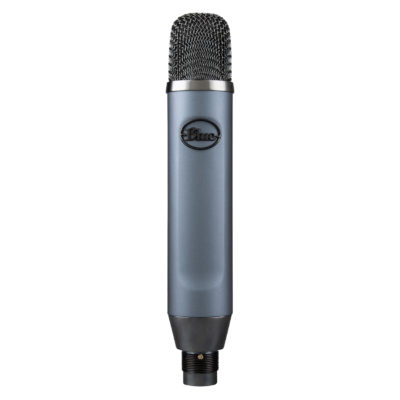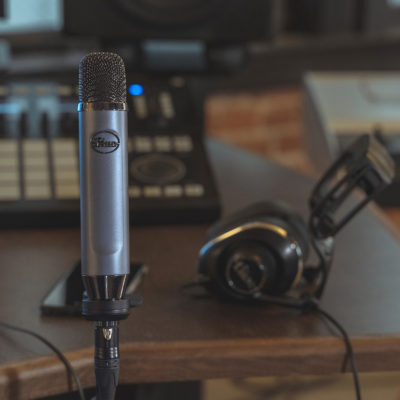New Gear Review: Ember Microphone by BLUE
BLUE is one of the more innovative microphone companies at work today, with a history of flamboyant and boundary-pushing designs, meant to delight both the ear and eye.
The company started by repairing high-end vintage microphones, but quickly expanded to developing its own designs, thanks to the expertise of Latvian audio engineer Martins Saulespurens. Success quickly followed.
Higher-end microphones like their Dragonfly and Bottle models come with custom shock mounts and unique finishes and colors, with each mic boasting a diverse feature set to boot.
But BLUE is also known for their more affordable mics, of which they have quite a range. Following the release of Apple’s now infamous Garageband software, BLUE released the Snowball microphone, which connected directly via USB, foregoing the need for any XLR cables or audio interface whatsoever. The Snowball saw the popularity of the company skyrocket, and they have since become a major player in supplying podcasters and other content creators with several USB offerings.
Into that fray arrives the Ember condenser microphone, a new offering from BLUE that aims to satisfy both musicians and content creators alike. And it’s worth mentioning early on that the Ember is offered at a very affordable $99 USD, making it a microphone within reach of many. So how does it stand up to its competitors among the budget microphone crowd?
Features
The Ember arrives in a stylish box, with a simple yet informative instruction packet. Its body is made of an attractive metal with a matte grey coloring, and the overall feel is incredibly solid and reassuring. BLUE notes that the slim body design of the Ember is meant to stay out of the way in tight recording sessions, all while managing to feel sturdy on a mic stand.
The Ember is about as stripped down as a microphone can get, though this isn’t necessarily a fault. It’s pretty much a plug-and-play affair, though you’ll need an interface with a phantom power equipped preamp due to the XLR connection and condenser design.
The Ember boasts a frequency response range of 38Hz to 20kHz, with a maximum SPL (sound pressure level) of 132dB. The mic utilizes a tight cardioid pickup pattern and does a great job of rejecting sounds coming from outside of this region, which is ideal for podcasting where multiple guests may be squeezed into a small space.
The Ember comes with a small microphone stand attachment that should work well for most recording scenarios. If you’re dealing with quieter sources and higher gain settings, it would probably be fruitful to use a shock mount with the Ember to reduce picking up any ambient noise.
In Use
We were able to test the Ember on a variety of source material, including both male and female vocals, guitar amp, acoustic guitar, and a variety of percussion. When placed within six to eight inches of a vocalist, the Ember faired well, handling dynamics with ease, and producing a clearly-defined high and midrange. Surprisingly, the Ember exhibited a nice, airy presence in the top end—something you’d expect from a mic 2-3x its sticker price. Given the fact that its frequency response only goes down to 38Hz, the Ember wouldn’t necessarily be the first mic we’d reach for when recording more bass-heavy material, such as an acoustic bass or bass amp.
When placed slightly off-axis in front of a Fender Champ tube amp, the Ember worked well at capturing that trademark Fender sparkle, rounding off some of the high treble that can sometimes be associated with those kinds of amps.
Even if this mic wasn’t under $100 new, we would be impressed with its ability to shine on such a variety of timbres. While it wasn’t the most neutral sounding microphone we’ve tested, any coloration that was added felt subtle enough to not be a problem, and in fact offered a nice cohesion to anything recorded.
It goes without saying that the Ember is certainly suited to handle a podcaster’s needs as well. It reacted well to male vocals, capturing accurate details when whisper quiet or responding to louder vocals with more attitude, all without losing its clarity. Using the Ember in a close podcasting scenario also showed how well its cardioid design rejected off-axis material.
To Be Critical
It’s hard to fault a $100 condenser microphone, though if we were to be picky, we did notice a fair amount of noise on plosive sounds. A pop filter would definitely be needed if working with quieter, more dynamic material. Conveniently, BLUE offers a pop filter for sale separately, unsurprisingly named simply “the Pop.”
We’ve worked with higher-priced mics from BLUE in the past, including the Bluebird and Baby Bottle, and while it could just be that our memory is hazy, the Ember couldn’t quite compete with either of those higher-priced options. It doesn’t have the same high-end sparkle or low-mid detail.
Comparing the Ember to some of BLUE’s other offerings, however, including the versatile Yeti mic (which retails at only $30 more), it’s hard to not wish the Ember had a little bit more versatility. The Yeti has four recording patterns to choose from—cardioid, stereo, omnidirectional, and bidirectional modes—as well as an on-mic mute button and direct headphone monitor. While the Ember’s cardioid pickup pattern certainly works well, it would have been nice to have these other patterns to choose from in addition.
Summing it Up
All in all, the Ember did exactly as advertised, providing high quality audio recordings to musicians, gamers, and podcasters alike. Provided that you already have an audio interface and an XLR cable, getting started with the Ember is about as easy as possible (don’t forget the phantom power!).
While the Ember wouldn’t necessarily be the first mic we would reach for in a crowded mic closet, it certainly is a great choice as a first microphone for a budget home studio, given its ability to successfully capture a range of sources. It’s hard to see exactly who the Ember is best suited for when considering the entire range of BLUE microphones, however if you’re looking for a simple, no-frills condenser mic that will surely be reliable for years to come, the Ember comes highly recommended.
Leo Maymind is a producer, DJ, and writer living in Los Angeles, CA. He is obsessed with sound, and you can reach him at lmaymind@gmail.com.
Please note: When you buy products through links on this page, we may earn an affiliate commission.









[…] The company started by repairing high-end vintage microphones, but quickly expanded to developing its own designs, thanks to the expertise of Latvian Read more… […]